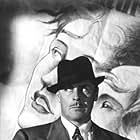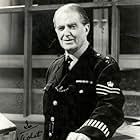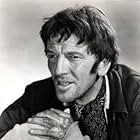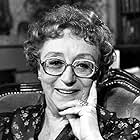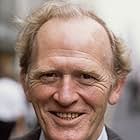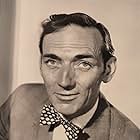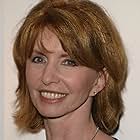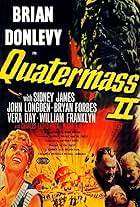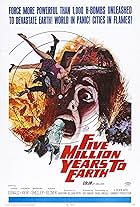IMDb RATING
6.6/10
7.4K
YOUR RATING
Professor Bernard Quatermass' manned rocket ship returns to Earth, but two of the astronauts are missing and the survivor seems ill and unable to communicate.Professor Bernard Quatermass' manned rocket ship returns to Earth, but two of the astronauts are missing and the survivor seems ill and unable to communicate.Professor Bernard Quatermass' manned rocket ship returns to Earth, but two of the astronauts are missing and the survivor seems ill and unable to communicate.
Jane Aird
- Mrs. Lomax
- (uncredited)
Margaret Anderson
- Maggie
- (uncredited)
Jane Asher
- Little Girl
- (uncredited)
Harry Brunning
- Night Porter
- (uncredited)
Ken Buckle
- Police Driver
- (uncredited)
Eric Corrie
- Maggie's Boyfriend
- (uncredited)
Edward Dane
- Station Policeman
- (uncredited)
Gron Davies
- Charles Green
- (uncredited)
- Director
- Writers
- All cast & crew
- Production, box office & more at IMDbPro
Storyline
Did you know
- GoofsVolkswagen Bus en route to the crash site is not the same Volkswagen Bus that arrives through the gate at the crash site. VW badge is larger, chrome trim is missing and license plate is different.
- Quotes
Prof. Bernard Quatermass: There's no room for personal feelings in science, Judith!
- Alternate versionsThe original 1955 "Quatermass Xperiment" print has the closing caption "The End"; the reissued version (with a still bearing the new title "The Quatermass Experiment" inserted into the opening credits) replaces this with "A Hammer Production Produced at Bray Studios".
- ConnectionsFeatured in Frances Farmer Presents: The Creeping Unknown (1959)
Featured review
Before a little British company called Hammer became famous for Dracula and Frankenstein, there were the adventures of Professor Bernard Quatermass. Based on the live BBC serial from 1953, The Quatermass Xperiment put Hammer on the film world map. How that happened it obvious from this tense, realistic, and gritty science fiction classic.
The film is immensely helped by an excellent cast. Brian Donlevy's Quatermass is the archetype science fiction film scientist: a scientist obsessed with their quest for science before turning having to deal with the consequences of that quest. Donlevy plays Quatermass to perfection as a scientist who is both horrified and fascinated by the events he has set in motion. It's a strong performance filled with realism. fascination and horror. The cast also includes terrific performances from Jack Warner as Scotland Yard's Inspector Lomax, Margia Dean who takes the potentially clichéd Judith Carroon and puts flesh and blood on the character, and David King-Wood as Quatermass's fellow scientist Doctor Briscoe. The best performance of the film may well be from the character who never speaks: Richard Wordsworth as Victor Carroon. Wordsworth perfectly plays both the horror of the lone surviving astronaut and also sympathy as the worst off victim of the Quatermass experiment. This is especially true in a scene where Caroon finds himself at a dock where a little girl approaches him with her doll. It reminds one of the scene from the Universal Frankensein where the seemingly innocent takes on a darker meaning. Overall, the film has a terrific cast of actors bringing it to life.
At a time when science fiction films were defined by the clichéd and outrageous monster and alien invasion films, this film (and its TV counterpart) went in the exact opposite direction. Director Val Guest choose to do the film not in the style of the time but in a near documentary style. That's why the film work's fifty years later: it seems real in that it is a product of its time are place. If Britian had started the space race in the mid-1950's, one feels this is how it would have been.
The film is also helped by two very strong elements: the black and white cinematography and the music score. Doing the film in black and white adds atmosphere to a film that is part alien invasion and part manhunt. It helps especially in the film's fiery finale. The music score by James Bernard is terrific in adding to the atmosphere of the film and it never intrudes, but just helps to bring one a little bit closer to the edge of one's seat. The film wouldn't be the same without either one of these two elements.
Yet as much as I would like to call this film perfect, it isn't. There is one thing that the film hits and misses on: special effects. The downside of the film being so much a product of its time is that when the special effects are looked back at from a distance, they look primitive. That's not to say that the special effects are bad. The prosthetics work in particular looks good even by today's standards as far as I'm concerned. The finale of the film is the most obvious spot where the special effects are a bit of a let down by modern standards. Then again, it is hard to compare special effects from one era to another so this is an issue for the viewer to decide on.
While the special effects may hamper the film for some, one must admit that The Quatermass Xperiment is a classic of the genre. From the terrific performance (espeically of Donlevy and Wordsworth), to the realistic style and tone, to the excellent cinematography, to the dark score by Jame Bernard, The Quatermass Xperiment is a tour de force for the more intelligent and less action based science fiction films. If you can put aside the mid-1950's special effects, you're going to find a tense, realistic, and gritty science fiction classic.
The film is immensely helped by an excellent cast. Brian Donlevy's Quatermass is the archetype science fiction film scientist: a scientist obsessed with their quest for science before turning having to deal with the consequences of that quest. Donlevy plays Quatermass to perfection as a scientist who is both horrified and fascinated by the events he has set in motion. It's a strong performance filled with realism. fascination and horror. The cast also includes terrific performances from Jack Warner as Scotland Yard's Inspector Lomax, Margia Dean who takes the potentially clichéd Judith Carroon and puts flesh and blood on the character, and David King-Wood as Quatermass's fellow scientist Doctor Briscoe. The best performance of the film may well be from the character who never speaks: Richard Wordsworth as Victor Carroon. Wordsworth perfectly plays both the horror of the lone surviving astronaut and also sympathy as the worst off victim of the Quatermass experiment. This is especially true in a scene where Caroon finds himself at a dock where a little girl approaches him with her doll. It reminds one of the scene from the Universal Frankensein where the seemingly innocent takes on a darker meaning. Overall, the film has a terrific cast of actors bringing it to life.
At a time when science fiction films were defined by the clichéd and outrageous monster and alien invasion films, this film (and its TV counterpart) went in the exact opposite direction. Director Val Guest choose to do the film not in the style of the time but in a near documentary style. That's why the film work's fifty years later: it seems real in that it is a product of its time are place. If Britian had started the space race in the mid-1950's, one feels this is how it would have been.
The film is also helped by two very strong elements: the black and white cinematography and the music score. Doing the film in black and white adds atmosphere to a film that is part alien invasion and part manhunt. It helps especially in the film's fiery finale. The music score by James Bernard is terrific in adding to the atmosphere of the film and it never intrudes, but just helps to bring one a little bit closer to the edge of one's seat. The film wouldn't be the same without either one of these two elements.
Yet as much as I would like to call this film perfect, it isn't. There is one thing that the film hits and misses on: special effects. The downside of the film being so much a product of its time is that when the special effects are looked back at from a distance, they look primitive. That's not to say that the special effects are bad. The prosthetics work in particular looks good even by today's standards as far as I'm concerned. The finale of the film is the most obvious spot where the special effects are a bit of a let down by modern standards. Then again, it is hard to compare special effects from one era to another so this is an issue for the viewer to decide on.
While the special effects may hamper the film for some, one must admit that The Quatermass Xperiment is a classic of the genre. From the terrific performance (espeically of Donlevy and Wordsworth), to the realistic style and tone, to the excellent cinematography, to the dark score by Jame Bernard, The Quatermass Xperiment is a tour de force for the more intelligent and less action based science fiction films. If you can put aside the mid-1950's special effects, you're going to find a tense, realistic, and gritty science fiction classic.
- timdalton007
- May 20, 2008
- Permalink
- How long is The Quatermass Xperiment?Powered by Alexa
Details
- Release date
- Countries of origin
- Language
- Also known as
- The Creeping Unknown
- Filming locations
- East India Docks, London, Greater London, England, UK(derelict boat scene with little girl)
- Production company
- See more company credits at IMDbPro
Box office
- Budget
- £45,000 (estimated)
- Runtime1 hour 18 minutes
- Color
- Sound mix
- Aspect ratio
- 1.37 : 1(original/negative aspect ratio, alternative theatrical ratio)
Contribute to this page
Suggest an edit or add missing content

Top Gap
By what name was The Quatermass Xperiment (1955) officially released in India in English?
Answer








